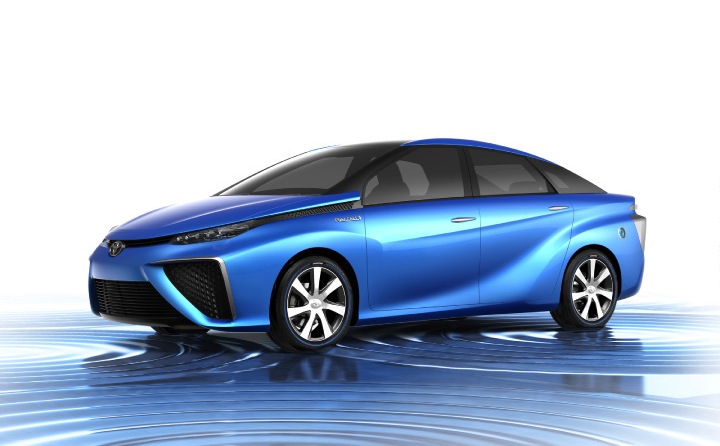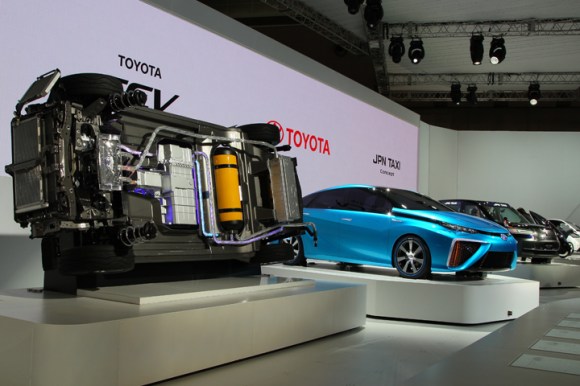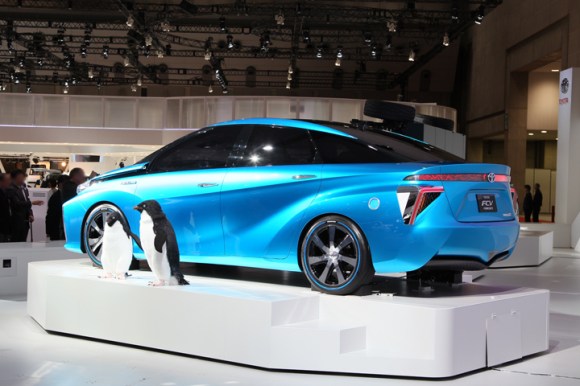
Although the technology has been talked about for quite some time now, the concept of using oxygen and hydrogen to power an automobile seems poised to finally hit the market.
According to reports, the Toyota Motor Corporation has recently declared that their sedan-type Fuel Cell Vehicle (FCV) will begin production at the end of this year. At the moment Toyota claims this would make them the first automaker in the world to market such a vehicle to the public at large.
The FCV carries a stock of hydrogen on board and uses oxygen from the air to generate power. It’s said that a single 5kg (11lbs) supply of hydrogen can carry Toyota’s FCV over 500km (310mi). This is probably a good thing since at the time of its initial launch, stations where hydrogen can be purchased will be few and far between, found in only four of Japan’s major urban centers: Tokyo, Nagoya, Osaka, and Fukuoka.
It’s also been reported while that the establishments of around 100 of these stations have been expected to occur over this year, they are currently behind schedule. As such the Japanese government has been stepping in to encourage faster development.
Like many new technologies, the FCV will initially sell for a high price. Previously it was expected to cost 10,000,000 yen (US$97,500), but as of this writing has been marked down to an expected 9,900,000 yen ($96,500) with hopes that certain subsidies will kick in and lower the price further over the year.
Toyota is aware that these vehicles aren’t going to sell like hotcakes in the early days and will only produce 50 cars a month when ready. The company is mainly aiming at national and local governments as well as wealthy individuals or corporations with a particular interest in eco-friendly cars as potential buyers. As such someone should probably consider setting up hydrogen stands in the ritzier parts of Japan as well.
Readers of the news reacted with cautious optimism. Several asked the questions “Where does the hydrogen come from?” and “In what way do we get the hydrogen?” The first question is by far the most important, as the method that the pure hydrogen is produced may cause a substantial amount pollution as well thus negating the whole environmental aspect of the car.
With regards to the latter question, when I first heard about hydrogen fuel cells I always imagined/hoped it’d be like those glowing energon cubes from the Transformers series, but based on this promotional video from last year it looks like you just pump the hydrogen into a tank like you do with regular old gasoline. However, this also begs the question: How much will the hydrogen cost?
Indeed, it’ll be a hard road ahead for the FCV with challenges in infrastructure, pricing, and public attitude to contend with. However, if this is truly the start of a wave of automobiles producing a small fraction of the emissions of regular combustion engines, my grey boogers may one day vanish into nothing more than bedtime stories for my grandchildren.
Source: Tokyo Web via My Game News Flash (Japanese)
Images & Video: Toyota



 Japan’s hydrogen fuel cell stations begin to open, but are they worth the switch?
Japan’s hydrogen fuel cell stations begin to open, but are they worth the switch? Honda readying a Fuel Cell Vehicle for buyers next year, just in time to challenge Toyota
Honda readying a Fuel Cell Vehicle for buyers next year, just in time to challenge Toyota Japanese professor develops device to allow cars to cleanly run on hydrogen from ammonia
Japanese professor develops device to allow cars to cleanly run on hydrogen from ammonia World’s first hydrogen powered vending machine unveiled by Coca-Cola at Osaka-Kansai Expo
World’s first hydrogen powered vending machine unveiled by Coca-Cola at Osaka-Kansai Expo Exhibit of globally popular ’80s and ’90s Japanese cars comes to Toyota Automobile Museum
Exhibit of globally popular ’80s and ’90s Japanese cars comes to Toyota Automobile Museum Starbucks Japan ready to get Year of the Horse started with adorable drinkware and plushies【Pics】
Starbucks Japan ready to get Year of the Horse started with adorable drinkware and plushies【Pics】 7 great places to see Mt. Fuji from without having to climb it
7 great places to see Mt. Fuji from without having to climb it Kyoto has had enough of rude tourists, created an infographic to show how to visit politely
Kyoto has had enough of rude tourists, created an infographic to show how to visit politely What does a kanji with 12 “kuchi” radicals mean? A look at weird, forgotten Japanese characters
What does a kanji with 12 “kuchi” radicals mean? A look at weird, forgotten Japanese characters We found possibly the quietest Japanese-style hotel in Tokyo’s bustling Shinjuku district
We found possibly the quietest Japanese-style hotel in Tokyo’s bustling Shinjuku district 7-Eleven Japan’s ramen-cooking robot whipped us up a bowl of noodles【Taste test】
7-Eleven Japan’s ramen-cooking robot whipped us up a bowl of noodles【Taste test】 Japan’s oldest largetooth sawfish in captivity back on display in Mie Prefecture
Japan’s oldest largetooth sawfish in captivity back on display in Mie Prefecture The etiquette rules for visiting Shinto shrines in Japan
The etiquette rules for visiting Shinto shrines in Japan Feast your multiple eyes on the Harajuku Kawaii Monster Cafe’s tasty, toothsome dishes
Feast your multiple eyes on the Harajuku Kawaii Monster Cafe’s tasty, toothsome dishes Japanese airlines offer discounted fares to international tourists
Japanese airlines offer discounted fares to international tourists Lacquerware supplier to emperor of Japan and Pokémon team up for new tableware
Lacquerware supplier to emperor of Japan and Pokémon team up for new tableware Cyberpunk anime meets traditional culture in Ghost in the Shell gold leaf Japanese changing screens
Cyberpunk anime meets traditional culture in Ghost in the Shell gold leaf Japanese changing screens Japan may add Japanese language proficiency, lifestyle classes to permanent foreign resident requirements
Japan may add Japanese language proficiency, lifestyle classes to permanent foreign resident requirements Hello Kitty Choco Egg figures are an adorable trip through three periods of Japanese pop culture【Pics】
Hello Kitty Choco Egg figures are an adorable trip through three periods of Japanese pop culture【Pics】 Japan’s otoshidama tradition of giving kids money at New Year’s gets a social welfare upgrade
Japan’s otoshidama tradition of giving kids money at New Year’s gets a social welfare upgrade Starbucks Japan releases new zodiac chilled cup drink for 2026
Starbucks Japan releases new zodiac chilled cup drink for 2026 Can a dirty butthole make you filthy rich in Japan? We’re starting a New Year’s lottery experiment
Can a dirty butthole make you filthy rich in Japan? We’re starting a New Year’s lottery experiment 7-Eleven Japan starts new temporary luggage storage service in over 300 branches
7-Eleven Japan starts new temporary luggage storage service in over 300 branches Disillusionment at Tsukiji’s tourist-target prices led us to a great ramen restaurant in Tokyo
Disillusionment at Tsukiji’s tourist-target prices led us to a great ramen restaurant in Tokyo Starbucks teams up with 166-year-old Kyoto doll maker for Year of the Horse decorations【Photos】
Starbucks teams up with 166-year-old Kyoto doll maker for Year of the Horse decorations【Photos】 Tokyo considering law requiring more trash cans following litter increase in heavily touristed area
Tokyo considering law requiring more trash cans following litter increase in heavily touristed area Tokyo’s Tsukiji sushi neighborhood asks tour groups to stay away for the rest of the month
Tokyo’s Tsukiji sushi neighborhood asks tour groups to stay away for the rest of the month Nintendo’s Kirby now delivering orders at Kura Sushi restaurants, but not in Japan
Nintendo’s Kirby now delivering orders at Kura Sushi restaurants, but not in Japan Tokyo event lets you travel back in time, for free, to celebrate 100 years since Showa era start
Tokyo event lets you travel back in time, for free, to celebrate 100 years since Showa era start Sanrio theme park in Japan announces plans to expand into a Sanrio resort
Sanrio theme park in Japan announces plans to expand into a Sanrio resort Stamina-destroying “Paralysis Noodles” are Tokyo’s newest over-the-top ramen innovation
Stamina-destroying “Paralysis Noodles” are Tokyo’s newest over-the-top ramen innovation Survey asks foreign tourists what bothered them in Japan, more than half gave same answer
Survey asks foreign tourists what bothered them in Japan, more than half gave same answer Japan’s human washing machines will go on sale to general public, demos to be held in Tokyo
Japan’s human washing machines will go on sale to general public, demos to be held in Tokyo Japan’s deadliest food claims more victims, but why do people keep eating it for New Year’s?
Japan’s deadliest food claims more victims, but why do people keep eating it for New Year’s? We deeply regret going into this tunnel on our walk in the mountains of Japan
We deeply regret going into this tunnel on our walk in the mountains of Japan Studio Ghibli releases Kodama forest spirits from Princess Mononoke to light up your home
Studio Ghibli releases Kodama forest spirits from Princess Mononoke to light up your home Major Japanese hotel chain says reservations via overseas booking sites may not be valid
Major Japanese hotel chain says reservations via overseas booking sites may not be valid Put sesame oil in your coffee? Japanese maker says it’s the best way to start your day【Taste test】
Put sesame oil in your coffee? Japanese maker says it’s the best way to start your day【Taste test】 No more using real katana for tourism activities, Japan’s National Police Agency says
No more using real katana for tourism activities, Japan’s National Police Agency says Starbucks Japan reveals new sakura drinkware collection, inspired by evening cherry blossoms
Starbucks Japan reveals new sakura drinkware collection, inspired by evening cherry blossoms Updated cherry blossom forecast shows extra-long sakura season for Japan this year
Updated cherry blossom forecast shows extra-long sakura season for Japan this year Toyota proposes a future where cars become pizza shops, hotels, and occasionally cars too
Toyota proposes a future where cars become pizza shops, hotels, and occasionally cars too Toyota to Unveil Driverless Car at Consumer Electronics Show
Toyota to Unveil Driverless Car at Consumer Electronics Show Synthetic fossil fuels made from light, water, and CO2 in the air tested in Osaka
Synthetic fossil fuels made from light, water, and CO2 in the air tested in Osaka Toyota goes full otaku, makes 40 kawaii mascots for every part of the car
Toyota goes full otaku, makes 40 kawaii mascots for every part of the car Tokyo Motor Show 2013: Cars! Crowds! Comely models! 【Photos】
Tokyo Motor Show 2013: Cars! Crowds! Comely models! 【Photos】
Leave a Reply